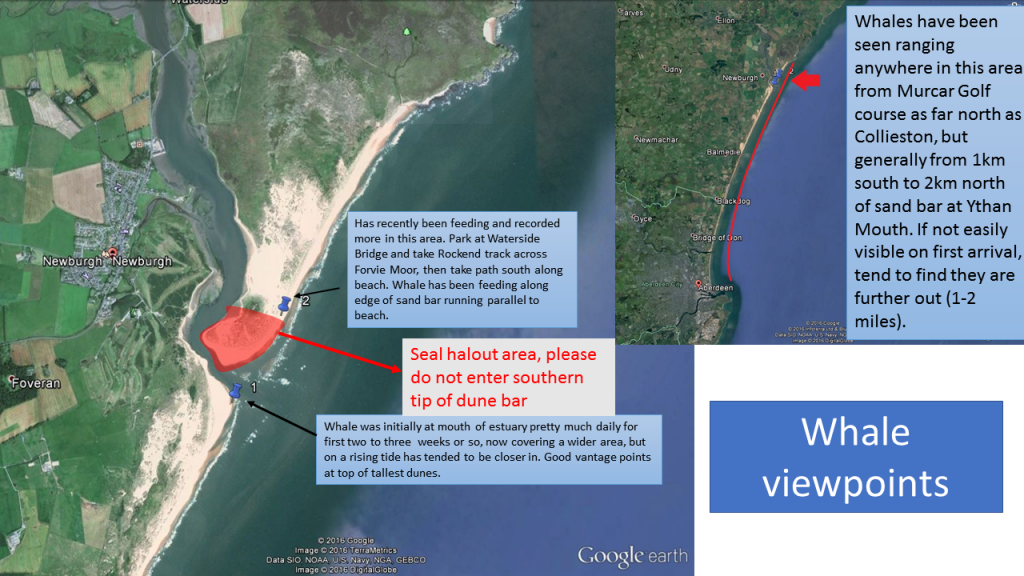If you’re desperate to see humpback whales, then your best chance at the moment is to head to Aberdeenshire where a humpback whale has been seen since 24 th July 2016.
This adult (above) was first photographed during our National Whale and Dolphin Watch by Eilidh Watson and was incredibly taken right from the shore in Newburgh, Fife! Since 28th August it has been confirmed that two animals have been using the area at the same time, with the last reported sighting being on 2nd October ! Please check our recent sightings page to see if any have been seen since.
 This infographic was produced by our Regional Coordinator, Kevin Hepworth and our Research Assistant, Sonia Doblado back in August.
This infographic was produced by our Regional Coordinator, Kevin Hepworth and our Research Assistant, Sonia Doblado back in August.
Humpbacks were seen in various spots around Scotland during the National Whale and Dolphin Watch back at the end of July, from the Moray Firth in the east and off Stoer Head lighthouse in the west. Humpback whales are often seen around the Hebrides and the Shetland Islands as well (as Figure 2 below shows). 2015 was a bumper year for humpacks including a sighting in Liverpool Bay as well as between the Isles of Scilly and Cornwall and off the coast of Norfolk.
It came as a real surprise to us in the Sea Watch office when we recently received word of possible humpback whales off of Cardigan, in west Wales around two weeks ago. We were a little sceptical of this sighting as it would be very unusual. However, after later receiving word of another possible sighting of two humpback whales at nearby Aberporth, we began to get excited about the possibility of seeing these amazing animals so close to us (just 9 miles from our New Quay office as the whale swims)! Without any photographic evidence, these sightings unfortunately remain unconfirmed. But we still hold out hope!
It’s not completely unheard of for humpbacks to be spotted in Cardigan Bay. Three adult humpbacks were spotted 100 metres off shore at Yyns Lochtyn, near Llangrannog, Ceredigion in July 2005. You can read more about it here:http://news.bbc.co.uk/1/hi/wales/mid/4134902.stm
Humpback whales are part of the suborder Mysticeti, otherwise known as baleen whales. This name refers to the comb-like plates which hang from their upper jaw. These plates have stiff hairs that filter food out of the vast amounts of water taken into the mouth during feeding, acting as a kind of sieve.
Humpback whales are easily identified from their distinctive tail flukes, knobbly head and long flippers, as well as its habit of raising its fluke high into the air when making a deep dive. The shape of the tail fluke (image below), as well as their markings, are unique to each whale, and so can be used for recognition of individuals. The body is large and stocky; an adult can measure up to 15 metres in length, and weighs up to 35 tonnes.
Humpbacks are a wide-ranging species with distinct seasonal changes in distribution, they will migrate thousands of kilometres to breed and feed. They spend much of the year close to the shore or to islands, but will migrate across the open sea. Traditionally the species has rarely been seen in British waters, but occasionally encountered off the west coast of Ireland and northern Scotland in summer, on its way from wintering and breeding grounds off the coasts of Africa to feeding grounds mainly around Iceland. It is hoped that a recent increase in sightings reflect a healthier population in UK waters post-whaling. We now need to move our attention to affects of other human activities such as ghost fishing, which is already taking a toll on this apparently recovering population. Ghost fishing is what happens when fishing nets have been abandoned, lost or dumped. These nets move via the ocean’s currents, making them hard to track and as they move trap marine life. These small, entangled fish act as bait for larger marine predators such as sharks, whales, turtles and dolphins; in turn these may then become entangled too. You can read more about ghost fishing here: http://www.seawatchfoundation.org.uk/the-phantom-menace/
Written by Emma Powell, Intern at Sea Watch Foundation 2016.




























